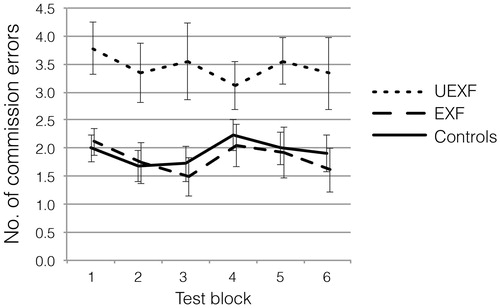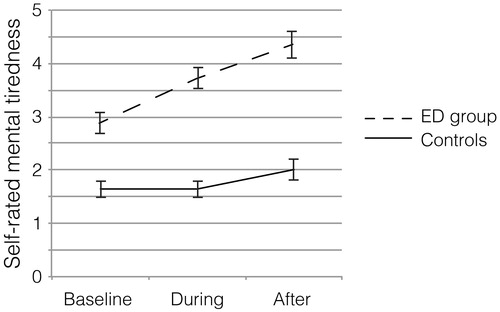Figures & data
Table 1. Diagnostic criteria for exhaustion disorder according to the National Board of Health and Welfare.
Table 2. Demographics, general cognitive level, SMBQ, and HADS for patients and controls.
Table 3. Ratings of fatigue and subjective cognitive functioning in patients (n = 25) and controls (n = 25).
Table 4. Neuropsychological test results of executive function and complex attention in patients (n = 25) and controls (n = 25).
Table 5. Neuropsychological test results of basic and sustained attention in the CPT-II in patients (n = 25) and controls (n = 25).
Figure 1. Mean response time (in milliseconds) with ± SEM for targets in the six consecutive blocks of the CPT-II test for the ED group (n = 25) and controls (n = 25).

Figure 2. Average number of commission errors (with ± SEM) across six test blocks of the CPT-II test for patients with stress-related exhaustion (Exhaustion Disorder (ED)) and controls (n = 25). The ED group is divided into patients with an unexpected fast response speed at the beginning of the test (UEXF; n = 9) and those with expected fast response speed in the first block (EXF; n = 16). The UEXF-group had more commission errors during the test compared to the other groups.

Figure 3. Mean mental tiredness (with ± SEM) reported by patients with stress-related exhaustion (Exhaustion disorder (ED)) (n = 25) and controls (n = 25) before, during and after the administration of the neuropsychological tests. The scale is graded as; 1 = No tiredness, 2 = Mild, 3 = Moderate, 4 = Average, 5 = Severe, and 6 = Very severe. None of the participants rated 7 = Worst thinkable tiredness.

